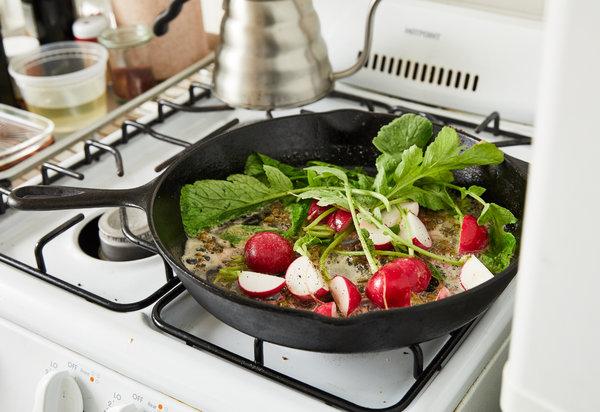Neighborhood restaurants occupy a very special place in my heart. These spots are not on any “hot” lists, the staff members are pleasant but generally indifferent to your presence, and the menus almost never change.
But none of that matters, because that’s not why you go. You go because you just can’t wash another skillet. You go because they have that one salad you’re always craving and tastes the same every single time. You go because it’s nice to have a place close by where you can sit and have a glass of wine and a crispy pork schnitzel all to yourself.
But maybe sometimes you don’t want to leave the house, and you’d like that crispy pork schnitzel to come to you. Or rather, I would like to bring that crispy pork schnitzel to you.
To be fair, my version is not technically schnitzel, and it’s not quite Milanese, either. I wouldn’t dare call it tonkatsu. The recipe is simply what it says it is, which is a pork chop that is very, very crispy. No pounding, no egg, no dipping, no dredging, no deep-frying. Just a thinly cut chop pressed into some store-bought bread crumbs and seared in a very hot, generously oiled skillet until it’s as golden brown as a graham cracker.
Most prepackaged pork chops are, in my opinion, cut too thin, which is bad news for anyone looking for a giant, juicy chop, but excellent news for anyone looking to make this recipe. The 1/2-inch pork chop is ideal for this use because it allows you to skip the pounding most pan-fried cutlets call for. The bread crumb coating also protects the meat from drying out, which it would almost certainly do if you were to try to get any color on a pork chop that thin.
I prefer bone-in pork chops, not just because I find nibbling on the bone to be extremely delightful, but because the bone prevents the meat from contracting in the skillet (which leads to uneven browning). That said, you could do this with boneless cutlets; just be sure to lightly press down on the meat as it cooks to make even contact with the skillet. Another preference of mine is using panko bread crumbs, since they are the crunchiest right from the get-go and stay the crispiest once cooked.
The greatest disservice you could do to something this crispy is douse it with sauce, but the pork does need a little something-something. I find that most any quick-cooking vegetable (sliced fennel or carrots, spears of asparagus, broccoli rabe) tossed in the skillet with browned butter with a few popped capers is perfect nestled alongside the chops (never on top!).

Radishes and capers take a turn in the pan. CreditMichael Graydon & Nikole Herriott for The New York Times. Prop Stylist: Kalen Kaminski.
Radishes are my favorite, though, for the way the heat softens them on the outside, giving them a sort of turnip-esque quality and wilting their delicious and often overlooked peppery leaves. Because I can’t help myself, I also like adding raw radishes at the end for extra crunch. (When it comes to radishes, for me more is more.)
While I truly can’t stand being told exactly how to eat (or telling you exactly how to eat), I feel I have to mention a crucial detail for enjoying this very crispy pork: Fresh lemon wedges must always be present, but they should always be served next to and never on the chop. Squeezing the whole thing with lemon juice will immediately soften everything you’ve worked so hard to crisp. Instead, I suggest squeezing each bite right before it goes into your mouth, and not a moment sooner.







